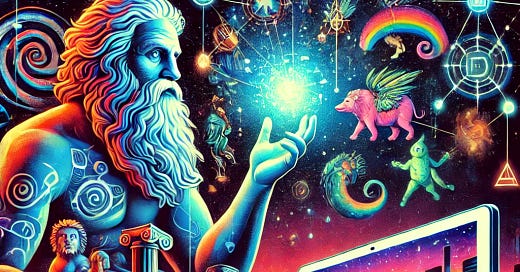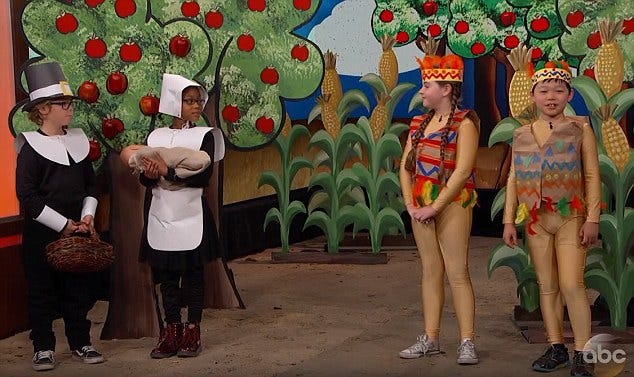When I was a kid, we had tall tales like Paul Bunyan, these larger-than-life characters and stories that essentially acted as creation myths for the United States.
We knew they weren’t true—no one really believed a giant lumberjack carved the Grand Canyon by dragging his ax—but these stories were shared widely and worked as a kind of social glue. They connected us to larger themes, gave us something to rally around, and even helped some of us understand actual facts by wrapping them in a layer of fanciful storytelling.
This past Thanksgiving, I found myself reflecting on the myths of my childhood and what they’ve been replaced with. As a kid, our school Thanksgiving pageants divided the room into pilgrims and Native Americans, with cornucopias and happily shared meals.
Sure, these narratives were oversimplified and deeply inaccurate, but they provided a foundation, a shallow starting point for collective understanding. Now, those myths have been largely dismantled, and rightly so. But in removing them, I can’t help but wonder—what have we put in their place?
Thanksgiving is now about….just eating, and shopping for sweet deals. I’m glad it is no longer a way wrong and racist dog and pony show; but we subbed out a fantasy and a lie for Black Friday.
The absence of myths feels like a void, and into that void has crept something far more corrosive: fake news, inescapable cycles of exploitive capitalism, conspiracy theories, and misinformation.
Perhaps our societal demand for 100% truth has paradoxically left us more susceptible to worse lies?
The Role of Myths in Society
To understand the implications of losing our myths, it helps to consider why myths existed in the first place. Throughout human history, myths have served as cultural scaffolding, giving people a framework for shared identity and meaning.
Joseph Campbell, the renowned mythologist, argued that myths are universal—archetypal narratives that resonate deeply with our human experience. They connect us to universal truths about love, courage, sacrifice, and the struggle to understand our place in the world. Similarly, Yuval Noah Harari has pointed out that shared myths, whether about religion, nations, or even money, enable cooperation on a massive scale. These stories don’t have to be factually accurate to be meaningful. Instead, they offer emotional weight and societal coherence.
Cognitive scientists, like Jonathan Gottschall, have also demonstrated that storytelling is intrinsic to human cognition. We process and remember information better when it’s embedded in a narrative. The story of Paul Bunyan didn’t replace the scientific fact of erosion; it enriched it, giving it a memorable, engaging frame.
What Happens When Myths Disappear?
The problem with dismantling myths is not the pursuit of truth itself—accuracy matters—but the failure to recognize that myths served a purpose beyond the literal. In removing flawed narratives without replacing them with new ones, we’ve inadvertently created a cultural vacuum. And vacuums don’t stay empty for long.
1. Social Fragmentation
Myths once provided a shared cultural script, a set of stories everyone knew and could draw from. Without these, society becomes increasingly fragmented, as people turn to smaller, more polarized narratives that divide rather than unite. Sociologist Robert Putnam has documented the decline of social capital and communal rituals in his book Bowling Alone. This decline mirrors the erosion of shared myths, leaving individuals disconnected from a broader cultural identity.
2. Loss of Wonder and Imagination
Stripped of myths, facts alone can feel sterile. Tall tales added a sense of wonder and playfulness to our understanding of the world. Without this imaginative layer, there’s a risk of disengagement, particularly among children, who might find the world of pure facts less compelling.
3. The Rise of “Worse Lies”
Ironically, in our effort to eliminate false narratives, we’ve opened the door to more pernicious forms of misinformation. Myths like Paul Bunyan were never meant to deceive; they were meant to entertain and unify. Fake news and conspiracy theories, by contrast, are designed to manipulate and divide. Without positive, unifying myths, people may turn to harmful narratives to fill the void.
4. Erosion of Civic Rituals
Rituals like Thanksgiving pageants or even Fourth of July parades—problematic as they might have been—provided opportunities for communal reflection. In dismantling these traditions without thoughtful replacements, we’ve lost occasions for collective storytelling and connection.
5. The Vanishing of “Act-As-If”
In a discussion with my good friend Ryan Estes, he mentioned the important role of “act as if” behavior, which means our job isn’t to verify truths, just to accept them and act as if they were true. If we applied it to religion, it would mean that if we were raised Christian, and went with our friend to their mosque, we wouldn’t countermand all of the teachings, we would “act as if” everything we’re hearing is true. You can see this takes a hearty serving of mental fortitude, so it’s no wonder there’s less and less of it.
6. The Self-Made Crown is Weighing Us Down
As myths have been expunged from our record, gods and goddesses removed from the cast of characters that influence and guide our lives on Earth, the functions, foibles, and fortunes of those myths have been placed directly on our shoulders. Whereas in the past, you might blame Zeus or Fortuna, pray to God, or curse Satan, now it is all YOUR RESPONSIBILITY. If you’ve done bad, it is 100% your fault. If you’ve done good, you’re 100% the reason. Our futures, both good and horrible, are 100% ours. And guess what; this too is a myth.
Reclaiming the Power of Myth
So, what’s the solution? How do we regain the benefits of myths without falling back on outdated or harmful narratives?
1. Create New Myths
We need contemporary myths that reflect modern values and diversity. These stories could be grounded in themes of sustainability, global unity, or scientific exploration. For instance, a modern “tall tale” might imagine a character who plants forests faster than they can be cut down, inspiring a new generation to think about conservation.
2. Reimagine Civic Rituals
Rather than eliminating flawed traditions, we can reinvent them. If we could recast some of the old myths in new outfits, find new natural or social phenomenology to retrofit myths onto, or find new ways to characterize/mythologize already popular social functions, we might be able to bring back some magic.
3. Blend Facts with Wonder
Educational systems can embrace storytelling as a tool for teaching facts. Imagine science lessons that incorporate myth-like narratives to engage students while instilling critical thinking skills.
4. Foster Shared Narratives in Media
The media landscape could focus on producing content that builds shared cultural narratives. Documentaries, films, and books that highlight human ingenuity, perseverance, and connection could become modern myths, inspiring collective pride and purpose.
In the rush to dismantle the myths of the past, we forgot one crucial detail: myths are not just made-up stories; they’re the threads that weave societies together. Without them, we risk unraveling into a patchwork of isolated individuals and divisive ideologies. The answer isn’t a return to falsehoods but a reimagining of how we tell our collective story.





